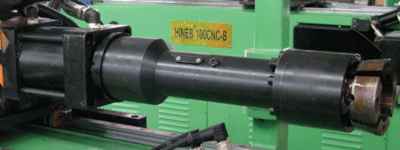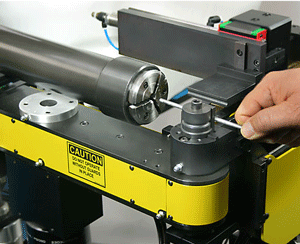- FMA
- The Fabricator
- FABTECH
- Canadian Metalworking
Categories
- Additive Manufacturing
- Aluminum Welding
- Arc Welding
- Assembly and Joining
- Automation and Robotics
- Bending and Forming
- Consumables
- Cutting and Weld Prep
- Electric Vehicles
- En Español
- Finishing
- Hydroforming
- Laser Cutting
- Laser Welding
- Machining
- Manufacturing Software
- Materials Handling
- Metals/Materials
- Oxyfuel Cutting
- Plasma Cutting
- Power Tools
- Punching and Other Holemaking
- Roll Forming
- Safety
- Sawing
- Shearing
- Shop Management
- Testing and Measuring
- Tube and Pipe Fabrication
- Tube and Pipe Production
- Waterjet Cutting
Industry Directory
Webcasts
Podcasts
FAB 40
Advertise
Subscribe
Account Login
Search
Getting a grip on tube bending
How a collet closer can influence quality
- By George Winton
- April 27, 2011
- Article
- Tube and Pipe Fabrication
A collet closer, commonly found on CNC or NC tube benders, serves an important role in the bending process. When quality is good, little attention is paid to its operation. When one or more quality parameters fall outside of acceptable limits, often the collet closer again is overlooked.
A collet closer is a simple yet important device that must sing in harmony with the overall bending process. It must open and close its grip with consistent repeatability on the tube at a precise point in time (see Figure 1).
Pneumatic units often are found on small CNC benders; hydraulic units are more likely to be used in cases in which the forces produced by pneumatics are not sufficient to hold a tube.
However, as far as troubleshooting a collet closer on a tube bender goes, what holds true for air often holds true for hydraulics.
Too Much Grip
Too much gripping force can turn the collet closer into a swaging machine; this is not good for quality. This is true for both hydraulic and pneumatic versions.
Typically this condition can be overcome by lowering the pressure to the collet closer. Some designs involve a cam-type action in which a mechanical thread is adjusted to change the closing pressure. However, even in this case, the line pressure must meet a minimum for sufficient clamping.
Too Little Grip
What are some telltale signs that the grip is too light? In the case of a CNC tube bender with a free-floating carriage, too little grip can cause the tube to slip inside the collet pads. This usually increases the distance between bends.
If the carriage is intended to follow the bend head as the bend is being formed (that is, if it is electronically geared), a light grip (with no shoulder in the collet) also can cause the distance between bends to vary as the carriage attempts to press the collet pads over the tube axially. This results in too little distance between bends.
Finally, a light grip can cause slippage between the collet pads and the tube, causing the plane rotation between bends to vary outside of a specified tolerance.
Just as decreasing the pressure to the collet closer decreases the griping force, the reverse is true—increasing the grip can often be accomplished by increasing the pressure. In other cases, a light grip on a tube can be compensated by adjusting the acceleration or deceleration time of the servomotor that controls the plane rotation. It is not the top speed of the plane rotations that causes the slip; it is the acceleration and deceleration, the sudden starting and stopping, that puts the most stress on the grip between the tube and the collet pads.

A direct-acting hydraulic collet closer can supply a large amount of gripping force. Photo courtesy of Hines Bending Systems.
A good way to put most of these problems to rest is to make sure the bender’s software warns the operator of a low-pressure condition.
Other root causes of a light grip might be:
- Incorrect collet pads installed
- Worn collet pads
- A mechanical malfunction of the closer
- An intermittent relay
- A sticking valve
- A lack of lubrication
About the Author

George Winton
3644 Burnette Road
Suwanee, GA 30024
888-321-1499
About the Publication
subscribe now

The Tube and Pipe Journal became the first magazine dedicated to serving the metal tube and pipe industry in 1990. Today, it remains the only North American publication devoted to this industry, and it has become the most trusted source of information for tube and pipe professionals.
start your free subscription- Stay connected from anywhere

Easily access valuable industry resources now with full access to the digital edition of The Fabricator.

Easily access valuable industry resources now with full access to the digital edition of The Welder.

Easily access valuable industry resources now with full access to the digital edition of The Tube and Pipe Journal.
- Podcasting
- Podcast:
- The Fabricator Podcast
- Published:
- 04/30/2024
- Running Time:
- 53:00
Seth Feldman of Iowa-based Wertzbaugher Services joins The Fabricator Podcast to offer his take as a Gen Zer...
- Trending Articles
Zekelman Industries to invest $120 million in Arkansas expansion

3D laser tube cutting system available in 3, 4, or 5 kW

Corrosion-inhibiting coating can be peeled off after use

Brushless copper tubing cutter adjusts to ODs up to 2-1/8 in.

HGG Profiling Equipment names area sales manager

- Industry Events
Pipe and Tube Conference
- May 21 - 22, 2024
- Omaha, NE
World-Class Roll Forming Workshop
- June 5 - 6, 2024
- Louisville, KY
Advanced Laser Application Workshop
- June 25 - 27, 2024
- Novi, MI
Precision Press Brake Certificate Course
- July 31 - August 1, 2024
- Elgin,



























